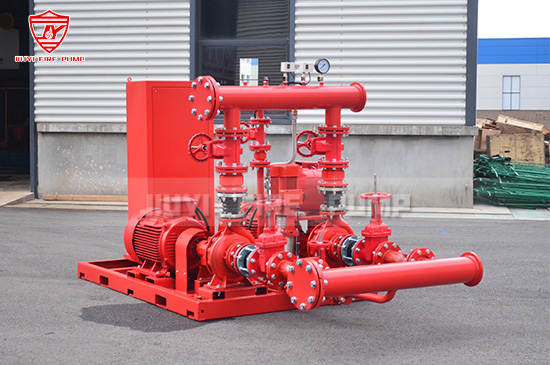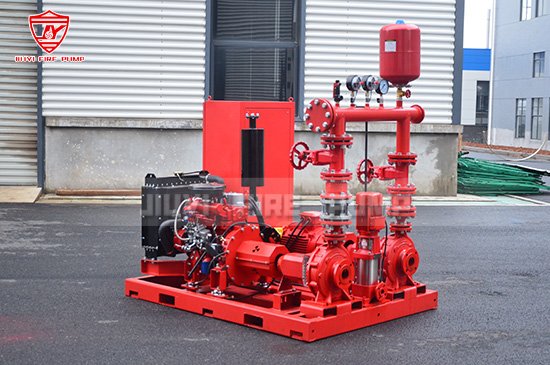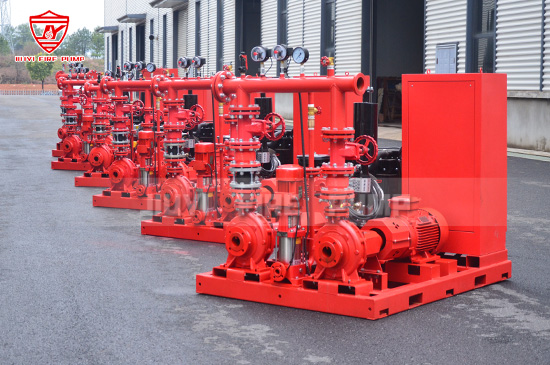Fire pumps are vital components in building fire protection systems. Their role is to ensure adequate water pressure is available during a fire emergency. However, these pumps don’t run continuously. Instead, they activate only when needed. So, what exactly triggers a fire pump to start running?
This article explains the primary conditions and mechanisms that cause a fire pump to operate. Whether you're a facility manager, fire safety engineer, or installer, understanding these triggers is essential for maintaining a compliant and responsive fire protection system.

A fire pump boosts the water pressure in a fire protection system, especially when the existing water supply (from a municipal source or static tank) is insufficient for the system’s design flow and pressure requirements.
Fire pumps are commonly used in:
High-rise buildings
Industrial facilities
Warehouses
Airports and transportation hubs
Anywhere sprinkler or standpipe systems are installed
They must be capable of providing immediate water pressure in the event of a fire — and that requires automatic activation mechanisms.
The most common and fundamental trigger for a fire pump to start is a drop in water pressure in the system. This drop typically occurs when:
A sprinkler head activates due to heat
A fire hose valve is opened
There’s a break in the piping system
When water is discharged from the system, the pressure decreases. Fire pump controllers are designed to monitor system pressure constantly. Once the pressure falls below a predetermined threshold (called the cut-in pressure), the controller automatically starts the fire pump.
For example:
If a jockey pump maintains system pressure at 140 psi, and the fire pump’s cut-in pressure is set at 120 psi, any event causing pressure to fall below 120 psi will trigger the fire pump.
A fire pump controller is the electrical device that receives input from pressure sensors and determines when to start or stop the pump. It can be:
Manual start only
Automatic start with manual stop
Fully automatic (start and stop)
In most fire protection systems (as per NFPA 20 standards), pumps are set to start automatically but can only be stopped manually — ensuring they continue to run throughout the fire event.
Modern controllers include:
Pressure sensors/transducers
Time delay relays (to avoid false starts from brief pressure dips)
Start/stop status displays
Alarm outputs
Jockey pumps are small, auxiliary pumps that maintain system pressure in normal conditions. They compensate for minor pressure drops caused by temperature fluctuations or small leaks. Their presence prevents unnecessary starting of the main fire pump for non-emergency conditions.
However, if the pressure drop exceeds the jockey pump’s capacity, the fire pump controller will sense the larger pressure dip and start the fire pump.
Pressure setpoints (example):
Jockey pump cut-in: 135 psi
Jockey pump cut-out: 140 psi
Fire pump cut-in: 120 psi
This sequence ensures the fire pump only starts when truly needed.

While most systems rely on pressure sensing, sprinkler systems also use flow switches (or paddle-type devices) installed in the pipes. These switches detect actual water movement and may also send a signal to initiate fire pump activation, especially in older or auxiliary systems.
Flow switches also serve to activate fire alarms and building management systems (BMS) to notify occupants and emergency responders.
NFPA 20 allows for remote manual start stations — often installed at fire alarm control panels (FACP) or fire command centers. These can be used by fire personnel to manually start the fire pump in an emergency, even if the automatic system hasn’t yet triggered.
However, this is not a substitute for automatic starting based on pressure or flow. It’s a backup method for specific operational control.
In some complex fire protection designs, the fire alarm system and pump controller are interconnected. When the fire alarm panel detects a fire signal (e.g., smoke detector activation), it can send a signal to start the fire pump as a proactive measure.
However, NFPA guidelines still require the pump to be independently capable of detecting pressure drops and operating even if the alarm system fails.
In diesel engine-driven fire pumps, the start signal activates:
The engine cranking system
Fuel injection system
Ventilation system (for enclosed pump rooms)
A battery bank ensures the diesel engine can start independently of external power. Diesel pumps have redundant starting methods (e.g., two battery banks and two start circuits) to ensure reliability.
To ensure reliability, NFPA 25 requires weekly fire pump testing. During this test:
Fire pump is manually started
Operation is observed and recorded
Pressure, flow, and run time are evaluated
Some systems are programmed for automatic test starts on a weekly basis. These tests are usually dry (no discharge), but full flow testing may be done periodically using test headers.
Several factors can interfere with the proper triggering of a fire pump:
Faulty or improperly calibrated pressure sensors
Electrical failure in the controller
Air trapped in pressure sensing lines
Controller left in "manual mode only"
Disconnected battery banks in diesel pumps
Incorrect jockey pump settings
Pump room temperature outside operating range
Routine inspection, testing, and preventive maintenance are critical to ensure the activation system functions flawlessly during a real emergency.
Once started, the controller sends a "pump running" signal to:
Fire alarm control panel
Central monitoring station (CMS)
Building management system (BMS)
Local audible/visual alarms
This signal confirms the fire pump has successfully started, and alerts the relevant teams to take necessary action.
NFPA 20 and local fire codes often require redundancy to ensure reliable operation:
Dual electric power sources or diesel backup
Two pressure sensors per controller
Locked control panels to prevent tampering
Power supply monitoring with alarms
In high-risk facilities, dual pump systems (primary and secondary) ensure water delivery even if the main pump fails.

To summarize, a fire pump is triggered by any significant pressure drop in the fire protection system — typically caused by water discharge during a fire event. Pressure sensors, controllers, and backup components work together to detect this drop and activate the pump automatically. Flow switches, manual remote starts, and alarm interconnections may also serve as triggers in certain designs.
Understanding what triggers a fire pump ensures the system is always ready when it matters most. Regular testing, proper calibration, and compliance with standards like NFPA 20 and NFPA 25 are essential to keep your fire protection system reliable and compliant.